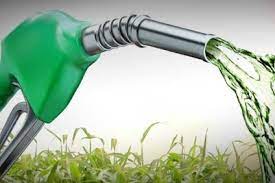27 Nov 2021 Ethanol

- The Government of India has approved a proposal to blend 20% ethanol with gasoline by 2025. Blending of ethanol will help in reducing the subsidy on sugar from 2023.
Ethanol:
- Ethanol is a biofuel which is produced from agricultural products like wheat, potato, sugarcane etc. Ethanol is produced in India by the fermentation process of sugarcane molasses. It is also used as a synthesis of organic compounds.
Steps taken by the government:
Some measures have been taken by the government to achieve energy efficiency in the transport sector, which are as follows-
- Ethanol Bleeding Programme: Recently the Government of India has released a roadmap for ethanol blending. In which it has been asked to change the target of ethanol blending (the target of 2030) to be completed by 2025. Under which up to 20% ethanol is to be mixed in petrol. Presently this mix is of 8.5%.
- Hydrogen Fuel: Recently the Government of India has also started the National Hydrogen Mission. Under this mission, the emphasis will be on hydrogen production from green energy modifications. The mission also includes linking India’s growing renewable energy potential with the hydrogen economy.
- Electric Vehicle Policy: The Electric Vehicle Policy 2020 released by the Government of India aims to cover 25% electric vehicles in total vehicles and 50% electric buses in buses by 2024. The main goal of the electric policy is to reduce air pollution as rising air pollution has raised health concerns in cities like Delhi.
India needs to learn from other countries:
- The level of ethanol blending in India is low as compared to other countries. Today most of the countries of the world are increasing the proportion of ethanol blending to reduce the use of fossil fuels. For example, Brazil is blending up to 48% ethanol in petrol. Ethanol blending will lead to the use of alternative and eco-friendly fuels.
Potential benefits of ethanol blending:
- Reducing crop burning and converting agricultural waste into biofuels to reduce greenhouse gas emissions.
- Alternative market will be available for the crops, which will increase the income of the farmers.
- Reduction in import dependence of fossil fuels.
Comparison between battery operated vehicles and ethanol fueled vehicles:
- Ethanol fueled vehicles are more efficient, economical and convenient than electric vehicles.
- In battery powered vehicles, the battery has to be charged with electricity, for which energy is usually obtained from coal. Therefore, it indirectly encourages the use of non-renewable energy. Whereas most of the ethanol fueled vehicles consume clean energy.
- Battery operated vehicles are less convenient as there is infrastructure problem for charging stations and they are not efficient for long distance travel. Whereas this is not a problem in ethanol fuel.
- Battery The life span of the battery in vehicles is 8 to 10 years, which increases the cost.
Limitations relating to energy derived from renewable sources:
- There is still not enough production capacity from renewable sources.
- Renewable energy is generally unreliable as it is more affected by natural phenomena such as solar energy wind energy etc.
- The cost of renewable energy is high. In addition, the maintenance cost adds up to the total cost.
- Renewable energy will also require replacement of conventional engines which can increase the cost of production of the vehicle.


No Comments